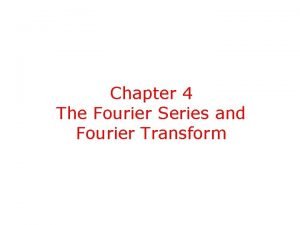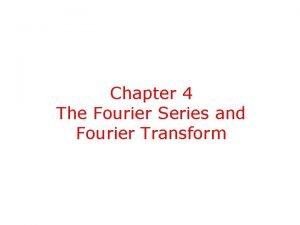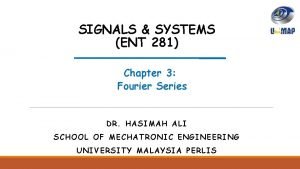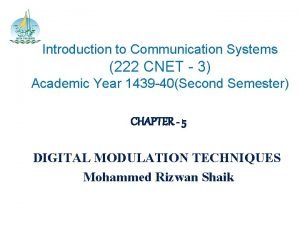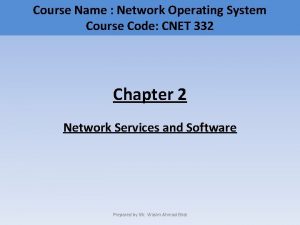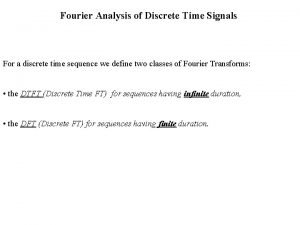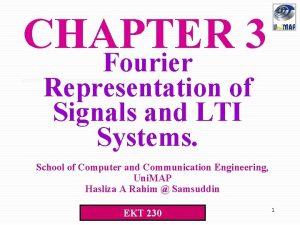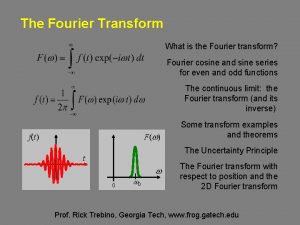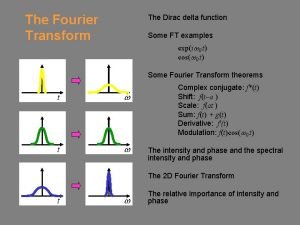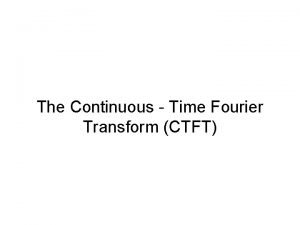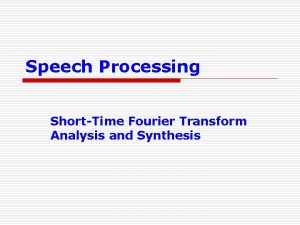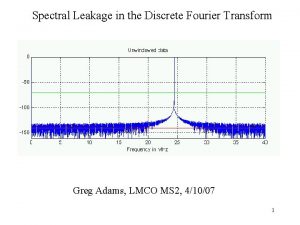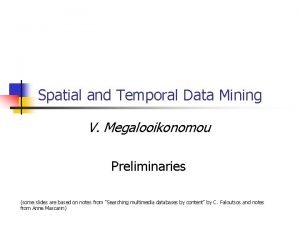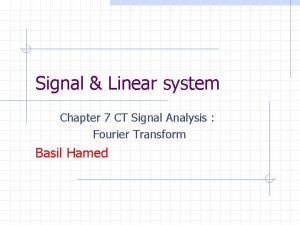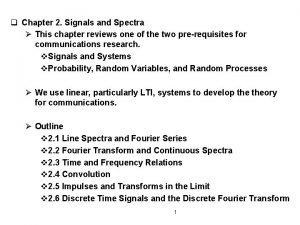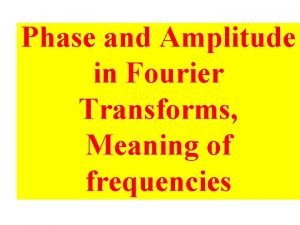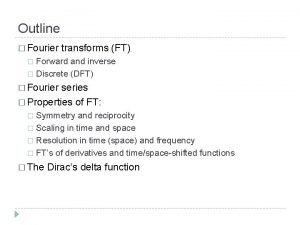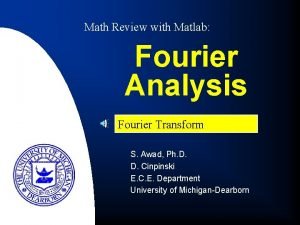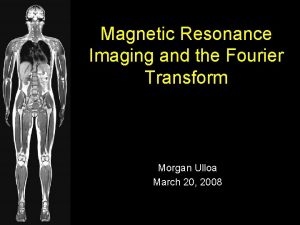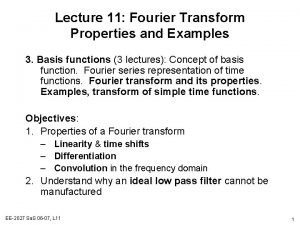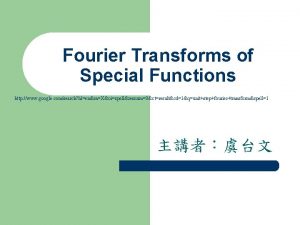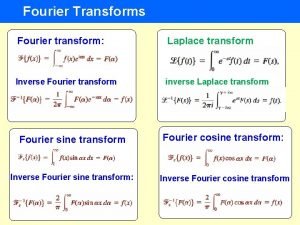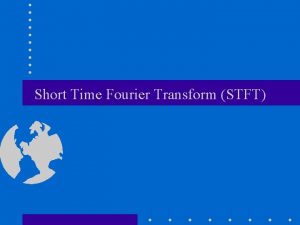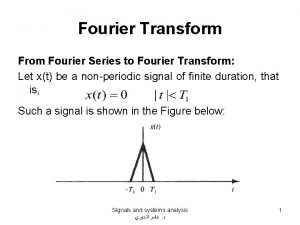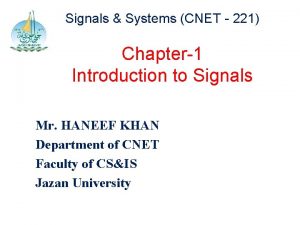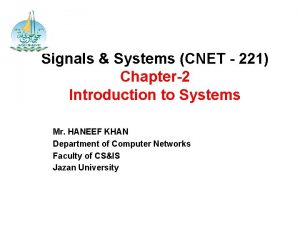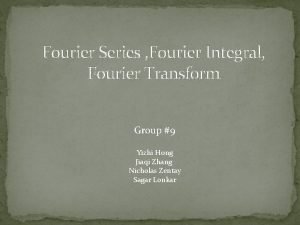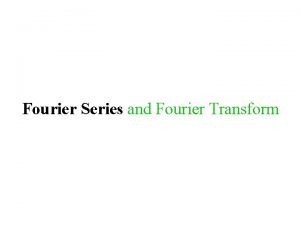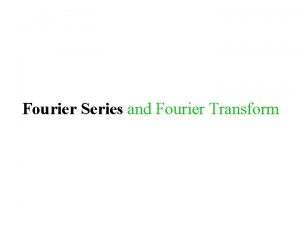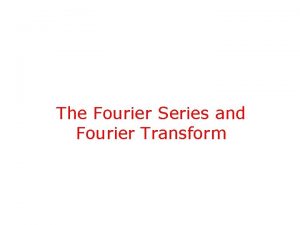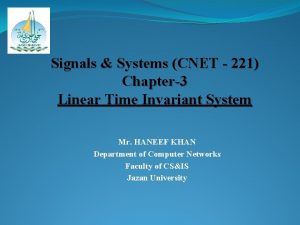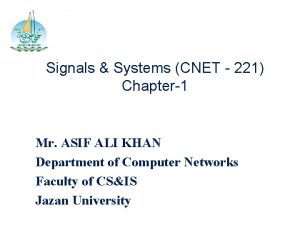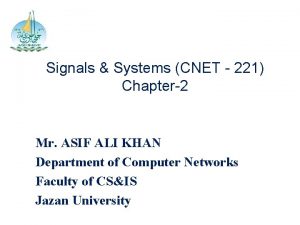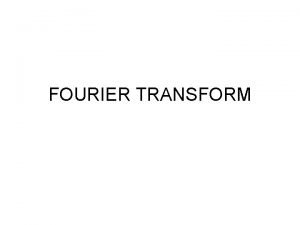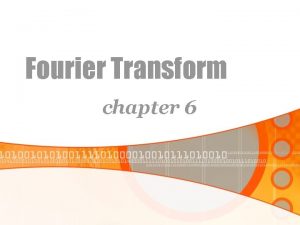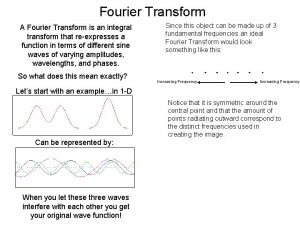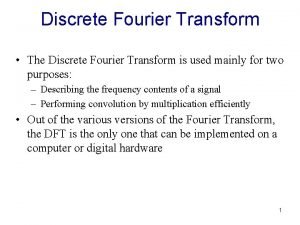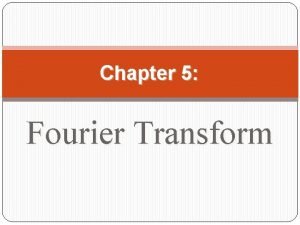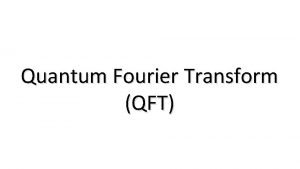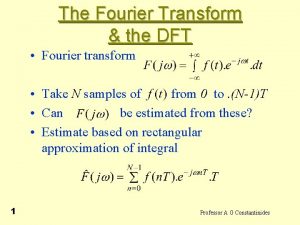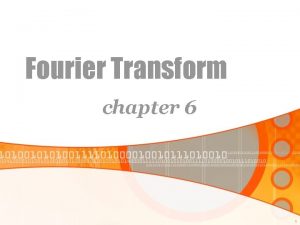Signals Systems CNET 221 Chapter5 Fourier Transform Mr


























- Slides: 26

Signals & Systems (CNET - 221) Chapter-5 Fourier Transform Mr. Haneef Khan Department of CNET Faculty of CS&IS Jazan University

Outline of Chapter-5 Fourier Transform Introduction 5. 1 Representation of Aperiodic Signals : The Continuous Time Fourier Transform 5. 1. 1 Development of the Fourier Transform : Representation of an Aperiodic Signal 5. 1. 2 Convergence of Fourier Transform 5. 1. 3 Examples of Continuous Time Fourier Transform 5. 2 The Fourier Transform for periodic signals 5. 3 Properties of Continuous Time Fourier Transform 5. 3. 1 Linearity 5. 3. 2 Time Shifting 5. 3. 3 Conjugation and Conjugate Symmetry 5. 3. 4 Differentiation and Integration 5. 3. 5 Time and Frequency Scaling 5. 3. 6 Duality 5. 3. 7 Parseval’s Relation 5. 4 The Convolution Property - Examples 5. 5 The Multiplication Property

Objective of Chapter-5 • To generalize the Fourier series to include aperiodic signals by defining the Fourier transform • To establish which type of signals can or cannot be described by a Fourier transform • To derive and demonstrate the properties of the Fourier transform

Fourier Representations Note: • A Fourier representation is unique, i. e. , no two same signals in time domain give the same function in frequency domain

Representation of Aperiodic Signals : Continuous Time Fourier Transform • Development of the FT : Representation of an Aperiodic Signal • Fourier Series (FS): A discrete representation of a periodic signal as a linear combination of complex exponentials • The CT Fourier Series cannot represent an aperiodic signal for all time • Fourier Transform (FT): A continuous representation of a not periodic signal as a linear combination of complex exponentials • The CT Fourier transform represents an aperiodic signal for all time. • A not-periodic signal can be viewed as a periodic signal with an infinite period.

Fourier Transform – CT Aperiodic signals • Consider the CT aperiodic signal given below:

Equations of Fourier Transform: Fourier Inverse Transform:

Convergence of Fourier Transform Dirichlet’s sufficient conditions for the convergence of Fourier transform are similar to the conditions for the CT-FS: 1. x(t) must be absolutely integrable 2. x(t) must have a finite number of maxima and minima within any finite interval. 3. x(t) must have a finite number of discontinuities, all of finite size, within any finite interval.

Examples of Continuous Time-FT • Example 4. 1 : P. no: 290

Example – 4. 1 Continued……

Example 4. 2 : P. no: 291

Example 4. 2 Continued. . • The Fourier transform for this example is real at all frequencies • The time signal and its Fourier transform are

Example 4. 2 : P. no: 292 • Properties of unit impulse: • Example: • Note: Unit Impulse has a Fourier Transform consisting of equal contributions at all frequencies.

Example 4. 4 P. no: 293

Example 4. 5 P. no: 294

Example 4. 5 Continued… • FT

Properties of Fourier Transform The equations of Fourier Transform 1. Linearity 2. Time Shifting 3. Conjugation and Conjugate Symmetry 4. Differentiation and Integration 5. Time and Frequency Scaling 6. Duality 7. Parseval’s Relation 8. Convolution and Multiplication

1. Linearity If then ax(t) + by(t) a. X (jω)+b. Y (jω)

2. Time Shifting If Then 3. Conjugation and Conjugate Symmetry The Conjugate property states that if

• Conjugate symmetry property : X(-jω) = X*(jω) 4. Differentiation and Integration

5. Time and Frequency Scaling If then x(-t) X(-jω)

6. Duality 7. Parseval’s Relation If x(t) and X(jω) are a Fourier transform pair, then

8(i). Convolution Property Consider LTI System h(t) is the impulse response of the LTI system. Convolution Property:

8(ii). Multiplication • The Convolution property states that convolution in the time domain corresponds to multiplication in the frequency domain.

Summary of properties of CTFT

Summary of properties of CTFT
 Integral of unit step
Integral of unit step Fourier series formulas
Fourier series formulas Sin in exponential form
Sin in exponential form Animals and human language chapter 2
Animals and human language chapter 2 Arbitrariness in human language and animal language
Arbitrariness in human language and animal language Communicative and informative signals
Communicative and informative signals Cnet communication
Cnet communication Cnet syndication
Cnet syndication Cnet
Cnet Cnet3
Cnet3 Cnet ftp
Cnet ftp Fourier analysis of discrete time signals
Fourier analysis of discrete time signals Discrete time fourier series
Discrete time fourier series Inverse fourier transform
Inverse fourier transform Fourier transform of dirac delta function proof
Fourier transform of dirac delta function proof Ctft
Ctft Short time fourier transform applications
Short time fourier transform applications Dft table
Dft table Parseval's identity for fourier transform
Parseval's identity for fourier transform Duality of fourier transform
Duality of fourier transform Pulse train fourier transform
Pulse train fourier transform Fourier transform amplitude and phase
Fourier transform amplitude and phase Forward and inverse fourier transform
Forward and inverse fourier transform Fourier transform of ramp function
Fourier transform of ramp function Mri fourier transform
Mri fourier transform Fourier transform of x
Fourier transform of x Unit step function fourier transform
Unit step function fourier transform
